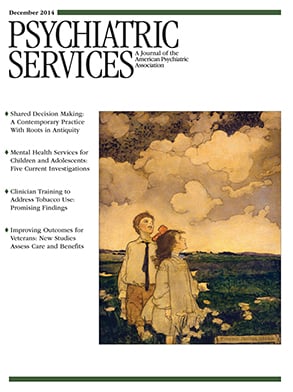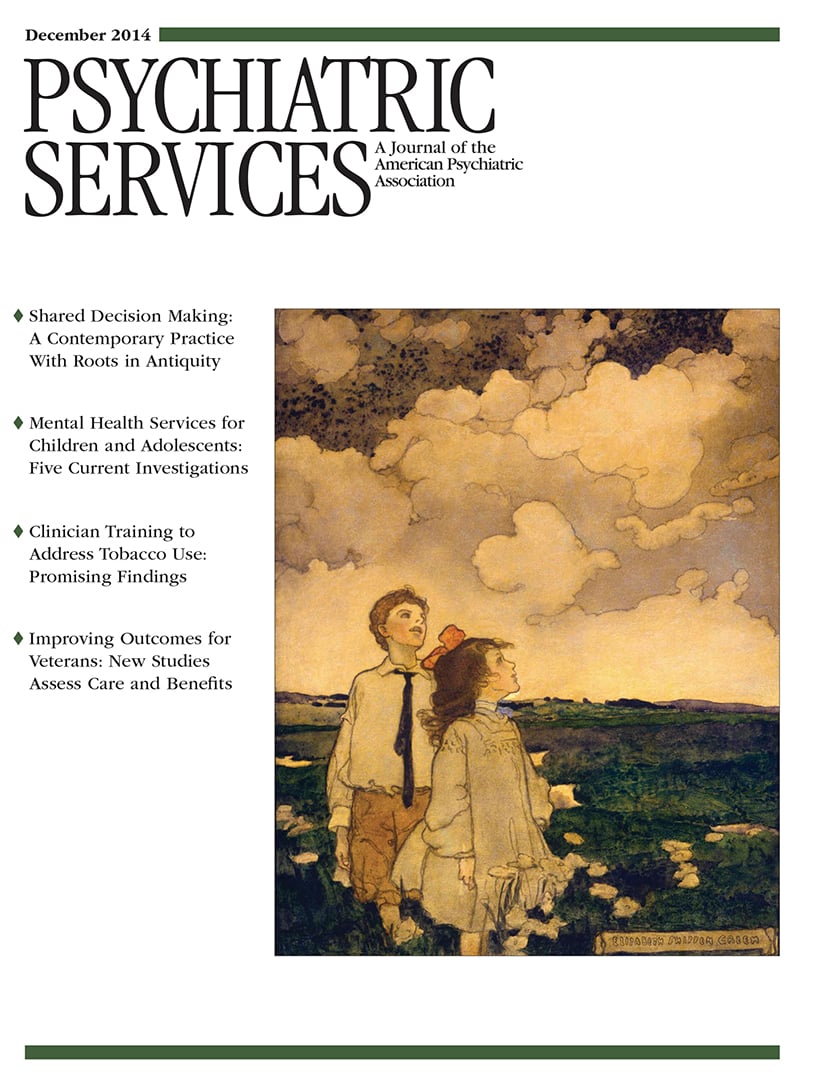Among people with mental illnesses, tobacco-related illness is the highest-ranking cause of death (
1). Yet smoking by patients continues to be an afterthought for most psychiatrists and behavioral health professionals. Smoking rates among individuals with a mental illness or another addiction are two to three times higher than in the general population. People with mental illnesses represent about one-third of the estimated 51 million adult smokers in the United States (
2).
Psychiatrists are ideally positioned to address tobacco use disorder among individuals with mental illnesses or substance use disorders, but there is little evidence to suggest that psychiatry as a profession participates in or contributes substantially to tobacco control activities, which include not only treatment but also larger issues of advocacy and public health. A recent major federal initiative focused on improving the health status of patients with serious mental illnesses through primary and behavioral health care integration demonstrated improvements on some health measures, but tobacco use outcomes did not improve (
3). This finding demonstrates that tobacco use continues to be a low-priority issue. This column reviews compelling reasons for psychiatrists to treat tobacco use disorder and addresses three main questions. Why aren’t the overwhelming consequences of tobacco use driving more psychiatrists to action? What can be done to remedy this situation? How can psychiatrists’ contributions be most effective?
Why aren’t psychiatrists acting?
Much of the work in tobacco cessation continues to be conducted in general medical systems and in primary care settings rather than in behavioral health settings. A recent review of nine community mental health sites showed that less than half of clinicians reported asking their patients about smoking (
12). Psychiatrists counsel smokers about quitting less often than do other physicians, and behavioral health professionals overestimate the frequency with which they deliver treatment related to tobacco use (
13). Inadequate training for psychiatrists likely impedes treatment of tobacco use disorder. In psychiatry residency training programs, education about treatment of tobacco use is not a requirement, and only half of programs provide it (
14).
In addition, attitudinal barriers may impede the delivery of tobacco use treatment. Categorizing tobacco use as a health condition and not an addiction undermines progress and assumes that primary care should be the treatment setting. Behavioral health professionals underestimate the readiness of their patients to address tobacco use and cite low motivation as a barrier to intervening (
12,
13)
. Organizational leaders may not yet prioritize tobacco use treatment because of similar knowledge and attitude barriers.
Despite barriers, behavioral health providers are well suited to delivering intensive tobacco cessation treatments because they have experience and training in treating other addictions and expertise in behavioral therapies. Behavioral health providers, who regularly see patients with chronic mental health or addiction issues, have many opportunities to intervene with patients in regard to tobacco use, a chronic, relapsing condition, and have longer office visits in which to do so. Integrated models are successful for other co-occurring addictions and would likely succeed for tobacco use disorder as well. Providers may feel frustrated with smoking cessation services that they view as ineffective because success rates are less than 30%, although these rates are similar to those for other addictions, obesity, and other chronic diseases.
Historically, behavioral health services developed separately from general medical services, with different funding sources, leadership structures, and regulations. This separation of general medical and behavioral health services has carried over to tobacco control. Tobacco control refers to coordinated efforts to reduce tobacco-related diseases and deaths by promoting quitting, preventing initiation among youths, and eliminating exposure to secondhand smoke through educational, clinical, regulatory, economic, and social strategies. State or county tobacco control programs are typically housed in health departments, and unfortunately, in most states they are still disconnected from offices of mental health. Partnerships are essential for progress.
In addition, mental health systems have been slow to adopt tobacco-related policies (for example, tobacco-free clinic grounds) and requirements for clinical interventions. Barriers cited by psychiatrists include the need to address their patients’ more immediate issues, lack of motivation to quit among patients, and unfamiliarity with cessation interventions among behavioral health staff (
13)
. Anecdotally, psychiatrists report concern that treating tobacco use represents a step toward the “slippery slope” of becoming a primary care physician, a move for which most feel unprepared. Program administrators may fear that tobacco-free grounds will reduce admissions and lower program census. Voluntary adoption of tobacco cessation treatments and policies does not seem to be effecting widespread change among behavioral health providers and programs. This suggests that mandatory policy interventions may be necessary.
How can psychiatrists contribute most effectively?
Provide treatment for all tobacco users
Clinical practice guidelines recommend interventions for all tobacco users, not just those expressing a desire to quit. For tobacco users not motivated to quit, motivational interventions should be provided. It is now time for full implementation of long-existing American Psychiatric Association guidelines recommending that psychiatrists treat tobacco use disorder among all their patients. Referrals to telephone quitline services may be appropriate for some.
Intervene during periods of temporary abstinence
All smokers should routinely have access to nicotine replacement therapy in treatment settings where acute abstinence occurs (such as emergency departments). These settings provide an opportunity to teach tobacco users about nicotine withdrawal and to motivate them to try or continue cessation treatments.
Provide and promote education
Tobacco training programs that are tailored to behavioral health settings are still rare. Extensive research in the past decade has led to advances in evidence-based practices for treating tobacco use. Psychiatry residency leaders can create standards for training to ensure that future generations continue this essential work.
Provide leadership to change treatment center policies
Now is the time to incorporate tobacco use treatment into behavioral health systems, as leaders and policy makers become more concerned about health disparities among people with mental illnesses. Policies should address both restricting tobacco in the environment and promoting assessment and treatment at all levels of care. Tobacco use treatment should be incorporated into substance use disorder policies.
Provide national leadership and advocate as physicians
Smokers with mental illnesses or substance use disorders deserve to be listed as a disparity group or priority population by national public health or tobacco control groups. Designation as a disparity group is needed to enhance funding and resources for tobacco use treatment. Because population approaches for reducing tobacco use may be less effective for these groups, a tailored, disparity-driven approach may be warranted. Psychiatrists must speak up within advocacy and professional organizations to focus on the need for tobacco control resources for this population.
Conclusions
A national movement for addressing tobacco use in behavioral health settings can be galvanized if more psychiatrists participate. As physician specialists in behavioral health and addictions, psychiatrists have great credibility that can be leveraged for tobacco control efforts. The strategies that have been effective in reducing the social desirability of tobacco and its use in communities need to be applied in the behavioral health system.
Many allies are essential for this effort: consumers and consumer-run organizations; families and family organizations; provider agencies; insurers; and federal, state, and local government groups. To undo the persisting link between smoking and mental illness, we must work together to disseminate education, develop local and national policies, and garner resources to ensure that every smoker who has a mental illness can access evidence-based treatments and to prevent smoking among young people with mental illnesses and substance use disorders.

